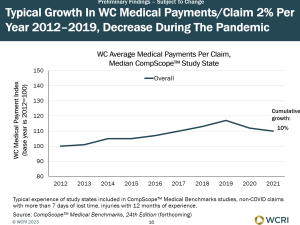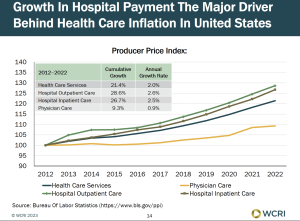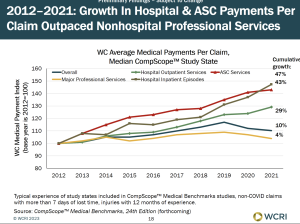Isn’t a problem. In most states. Today.
That is the headline takeaway from WCRI’s presentation last week…
First a few key factors.
- Drug spend is a much lower percentage of total medical today than it was a decade ago. I’m quite confident total drug spend in WC today is 40% lower than it was 15 years ago.
- That equals a reduction of about $2 billion.
- Facility costs continue to be the main driver of what inflation there is. Inpatient (IP) and outpatient (OP) hospital inflation averaged 2.5% annually from 2012 to 2022;
- Facilities account for 53% of total medical spend – 26% of which is OP; 9% is ASCs (Ambulatory Surgical Centers)
The details…
the best way to think about medical spend is per claim…this accounts for changes in claim volume (which is driven by injury rate and total employment).
Leaving out COVID’s impact (see end note for details) medical costs have barely budged for more than a decade…up a paltry 2 percent per year.

However…Facility costs are a big problem for all payers…exacerbated by massive consolidation in health systems which allows them to charge “facility fees” for services rendered in physicians offices and clinics. (what a scam…)

Work comp specifically…

National averages don’t mean much if you operate in states like Florida or Wisconsin, where poor controls on workers comp medical billing enable providers to hoover dollars out of employers’ and taxpayers’ pocket.
Of note, drug costs would likely be several hundred million dollars lower if it weren’t for the profiteers enabling physician dispensing.
What does this mean for you?
All costs are local…which means all cost management approaches must be as well.
COVID…medical costs for claims during COVID were down 10% – decreases in utilization and price drove this with utilization the main driver. Not surprising…during COVID no one wanted to go to any healthcare facility for anything not essential.
This was totally predictable...


